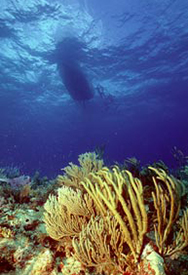Diving in Salt River Bay National Historic Park and Ecological Preserve
As its name implies, the Salt River National Historic Park and Ecological Preserve is unique for reasons of both history and nature. It is associated with several prehistoric sites dating back to A.D. 300, and Christopher Columbus landed here on his second trip to the New World. But not much of this past is evident on the land. Salt River Bay’s appeal to visitors is largely underwater. Of historical interest offshore are several large anchors belonging to sailing ships that range over the last 400 years.
The bay encompasses the largest stand of mangrove forest in the Virgin Islands-a rich estuarian area immediately inshore from a dramatic submarine canyon. The latter begins with a barrier reef in about 35 feet of water and plunges down to over 600 feet. The closeness of both an estuarian ecosystem and a deep-water submarine canyon brings together a rich collection of marine life in one very compact area. The National Park Service and the Government of the U.S. Virgin Islands administer the park jointly.
BASICS
Location: St. Croix, Virgin Islands
Skill level: Intermediate
Access: Boat
Dive support: Christiansted, St. Croix
Best time of year: Anytime is good
Visibility: Moderate to excellent (30 to 200 feet)
Highlights: Coral reefs, abundant marine life, warm clear water
Concerns: Strong currents, fire coral
Rules and Regulations
Dive Site Map
Dive Overview
All dives must be made from a boat. Several dive operators in Christiansted as well as one in the marina at Salt Rive run dive trips to the area. There are many places to dive both on the wall and on top in the shallow reef area. Dive operators all have their favorites; we found excellent diving at all the sites we visited.
Dive Sites
THE ANCHORS
This dive is on the top of the drop-off and consists of two large historic anchors. One is lying on the top of the reef and the other is on the side of a ledge and is overgrown with coral. The anchors, dating from the 1700’s, are interesting and good photographic backdrops. The reef is well developed, so there is more to see and do on the dive than just the anchors. The depth ranges from about 45-65 feet.
THE WALL
This generic heading is for any dive along the face of the wall that forms a side of the submarine canyon off Salt River Bay. The diving is very good all along the wall. Some spots are better than others because of the current. Because of the convoluted shape of the canyon, some areas are protected from the current, making it easier to return to your entry point. The area is divided into two general areas of diving-Salt River East (East Wall) and Salt River West (West Wall). Dives on the wall, in these areas, can be exiting because you never know what is going to swim by. With nothing but the deep blue ocean at your back, “insignificant” and “vulnerable” are the two best words to describe the feeling that washes over you. If you are lucky, you will get to see a squadron of manta rays zoom past you in the deep blue or a big, pelagic cruiser come in for a closer look. At the very least, you might find a spectacular tree of black coral or a canyon with coral bridges spanning the gap. Deep under the ledges in these canyons, it is still possible to find a few big groupers that haven't ended up on dinner plates in Christiansted. The area of Salt River West is noted for thick layers of plate coral-we saw stacks 20 feet high. Salt River East has more current flow, which encourages dense forests of gorgonians to decorate the wall.
DIVING RULES AND REGULATIONS
Diver-down flag must be displayed while divers are in the water.
No collecting of natural or cultural resources including coral or artifacts.
Observe Virgin Islands territorial rules and regulations regarding the taking of game and fish.
No anchoring on coral.
At Salt River Bay use moorings available at East and West Wall and provided by the St. Croix Diving Association.
Last Updated: October 26, 2012







